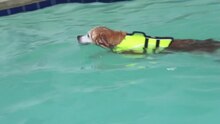Dog paddling
With dogs paddling on the one hand is the instinctive swimming movements of the dog and other quadrupeds but then also it reminds and relatively easy to learn swimming technique of man: the swimmer is with his body front side down somewhat horizontally in the water and moves his arms and legs under the water in the Sagittal plane back and forth or up and down, similar to how a dog swims.
Procedure and use in the dog
Most dogs can swim instinctively, but there are some breeds of dogs whose members cannot swim or have difficulty swimming due to their physique or a flat muzzle, such as: B. the bulldog or the boxer . ( There will probably be standard variants in one direction as well as in the other!) However, if the dogs swim, then they do it in the style of dog paddling and the movement pattern is largely the same: It is often compared to a "trot", but what that Movement only reproduces rather imprecisely.
Dog paddling is used for physiotherapy in dogs to build up the muscles; movements can be performed that would otherwise be too painful and at the same time the joints are spared. However, in the case of elbow and knee joint injuries, care should be taken to ensure that there is no overexertion and incorrect loading, and swimming should therefore be controlled; the duration of the exercise should be very short at the beginning. Otherwise there can also be the problem that the dog overestimates itself if the water has a current or in general with young or old dogs.
Use in humans
“Dog paddling” - with an emphatically critical connotation - is sometimes the form of swimming that is considered inefficient and with which v. a. Children in the young preschool age learn (poorly) to stay afloat. But it is also used as a neutral description for it, or recommended as the “first, very simple crawl” compared to the breaststroke.
"Dog paddling" (or "dog crawling") is also a form of exercise for learning to crawl swimming or, for advanced users, for improving the feeling of water; however, it has already evolved relatively clearly from the original form.
Unlike humans, learning to swim in great apes is quite difficult; However, swimming has also been documented in great apes, but their swimming technique does not resemble dog paddling, but breaststroke swimming . It is speculated that, among other things, the development of the quadruped walk in the common ancestor of the hominids led to the loss of instinctive dog paddling.
"Dog paddling" is or was (the spring is already quite old) also taught by the military as a silent type of swimming, since neither arms nor legs regularly pierce the surface of the water.
See also
Web links
- Retrievers run not trot when in water underwater shot ( Youtube video)
- Scientists Dive Into The Mystery Of The Dog Paddle (www.insidescience.org)
- Swimming sloth - Planet Earth II: Islands Preview - BBC One ( Youtube video with swimming sloth )
- How to paddle a dog ( wikiHow tutorial)
- Dog crawl ( Youtube video)
- How to Dog Paddle - Swimming Technique and Exercises (Instructions with Video)
Individual evidence
- ↑ 5 Dog Breeds That Can't Swim zestypaws.com, accessed August 20, 2019
- ^ Dissecting the dog paddle www.sciencenewsforstudents.org, February 5, 2015
- ↑ Dogs paddle against the pain rp-online.de, November 15, 2013
- ↑ In the hot summer months, our four-legged friends love the water pfoten-physio.com, May 22, 2018
- ↑ Training: Learning to swim without parents www.svz.de, May 22, 2017
- ↑ The lifeguard sees it with concern: “Dog crawling is not swimming” www.schwaebische.de (Tip: Use the Google cache because of the paywall), September 27, 2018
- ^ H. Manners, ME Carroll: A Framework for Physical Education in the Early Years . Routledge, 1995, ISBN 0-7507-0417-9 , p. 110. (Source taken from Wikipedia, not checked by myself)
- ↑ Sports medicine: Köpfchen in die Höh ' www.faz.de, September 18, 2012
- ↑ Learning to swim while playing www.uk-nord.de, 2009, accessed on August 20, 2019
- ↑ Swimming Basics www.medhealthletics.de
- ↑ Technique: With these exercises you can improve your feeling of water swim.de, December 17, 2015
- ↑ Great apes first filmed swimming www.scinexx.de, August 15, 2013
- ↑ Brief communication: Swimming and diving behavior in apes (Pan troglodytes and Pongo pygmaeus): First documented report onlinelibrary.wiley.com, July 30, 2013
- ^ US Departments of the Army and Air Force: Survival at Sea . United States Government Printing Office, 1950, p. 58.

